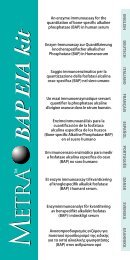METRA - Quidel Corporation
METRA - Quidel Corporation
METRA - Quidel Corporation
Create successful ePaper yourself
Turn your PDF publications into a flip-book with our unique Google optimized e-Paper software.
<strong>METRA</strong> ® PYD EIA Kit<br />
Catalog No.: 8010<br />
Reference No.: 952506 Revision Date: March 4, 2005<br />
SECTION 1 – Identification of the Substance & Manufacturer Information<br />
1.1<br />
<strong>METRA</strong> ® PYD EIA Kit (For In Vitro Diagnostic Use)<br />
1.2 The Metra ® PYD is a urinary assay that provides a quantitative measure of the excretion of pyridinium<br />
crosslinks as an indicator of type I collagen resorption, especially bone collagen.<br />
1.3 Manufacturer: <strong>Quidel</strong> <strong>Corporation</strong> – 10165 McKellar Court – San Diego, CA 92121<br />
Telephone No.: 1-858-552-1100 Toll Free No.: 1-800-874-1517 Fax No.: 1-858-453-4338<br />
1.4 Emergency No.: Poison Control @ 1-800-876-4766 (United States)<br />
SECTION 2 – Hazardous Ingredients Information<br />
2.1 Description of Components:Coated Strips, Stop Solution, Substrate Buffer, 10X Wash Buffer, Assay Buffer,<br />
Substrate Tablets, Enzyme Conjugate, Low/High Controls, and Pyridinoline Standards A F.<br />
2.2 Hazardous Ingredients: Dangerous solid or liquid substances present in >1% (or as required by<br />
applicable U.S., Canadian and E.U. regulations):<br />
CAS# EINECS<br />
Chemical<br />
Name<br />
1310-73-2 215-185-5 Sodium Hydroxide<br />
111-42-2 203-868-0 Diethanolamine<br />
Kit<br />
Component<br />
4702<br />
(Stop)<br />
4705<br />
(Substrate)<br />
Page 1 of 10<br />
%<br />
Classification :<br />
Weight US OSHA WHMIS EU Risk Phrases<br />
1.5% Corrosive Corrosive Xi R36/38<br />
11.5% Irritant Corrosive Xn R22 – 48/22<br />
**See Section 15 and Section 16 – Regulatory Information for additional information on hazard classifications.<br />
. SECTION 3 – Hazard Identification<br />
Emergency Overview: As part of good industrial and personal hygiene and safety procedure, avoid all<br />
unnecessary exposure to the chemical components of this kit and ensure prompt removal from skin, eyes, and<br />
clothing.<br />
3.1 Some components of this kit are considered as hazardous or dangerous preparations as defined by the<br />
Occupational Safety and Health Administration (OSHA), the Canadian Workplace Materials Information<br />
System (WHMIS), and the European Union (EU) Directives 1999/45/EC and 67/548/EEC. No significant<br />
health effects are anticipated from routine use.<br />
3.2 Contact with Stop Solution (#4702) or Substrate Buffer (#4705) to the eyes and/or skin may cause irritation<br />
upon a single exposure. Avoid prolonged contact.<br />
3.3 This kit contains material of animal origin and should be considered as potentially capable of transmitting<br />
infectious diseases.
<strong>METRA</strong> ® PYD EIA Kit<br />
3.4 All patient samples, contaminated test strips, and fluids should be handled as potentially infectious. Follow<br />
Universal Precautions as necessary.<br />
3.5 Warning Properties:<br />
Chemical Name Kit Component Degree Description<br />
Sodium Hydroxide 4702 (Stop) Poor<br />
Diethanolamine 4705 (Substrate) Fair<br />
SECTION 4 – First Aid Measures<br />
Special Instructions:<br />
Page 2 of 10<br />
Sodium Hydroxide is<br />
odorless.<br />
Diethanolamine has a mild<br />
ammonia-like odor.<br />
4.1 Inhalation: Inhalation of any component in this kit is unlikely. If a component of this kit is inhaled and<br />
causes discomfort, move exposed individual to fresh air. Seek medical attention if breathing<br />
is difficult or symptoms persist.<br />
4.2 Eye Contact: If a component of this kit enters the eyes and causes discomfort, wash eyes gently under<br />
potable running water for 15 minutes or longer, making sure that the eyelids are held open. If<br />
pain or irritation occurs, obtain medical attention.<br />
4.3 Skin Contact: If a component of this kit contacts the skin and causes discomfort, remove any contaminated<br />
clothing. Wash affected area with plenty of soap and water. If pain or irritation occurs, obtain<br />
medical attention.<br />
4.4 Ingestion: If a component of this kit is ingested, wash mouth out with water. If irritation or discomfort<br />
occurs, seek medical attention.<br />
SECTION 5 – Fire Fighting Measures<br />
5.1 Extinguishing Media: For small fires, use dry chemical, carbon dioxide, or alcohol-resistant foam.<br />
5.2 Special Fire Fighting Procedures: This material will not significantly contribute to the intensity of a fire. Use<br />
extinguishing material suitable to the surrounding fire. Utilize proper personal protective equipment when<br />
responding to any fire. Incipient fire responders should wear eye protection. Structural firefighters must wear<br />
Self-Contained Breathing Apparatus and full protective equipment. Move containers from fire area if it can be<br />
done without risk to personnel. If possible, prevent runoff water from entering storm drains, bodies of water, or<br />
other environmentally sensitive areas.<br />
5.3 Unusual Fire and Explosion Hazards: When involved in a fire, this material can decompose and produce<br />
irritating fumes and toxic gases (e.g., Carbon monoxide, Carbon dioxide).<br />
Explosion Sensitivity to Mechanical Impact: Not sensitive under normal conditions.<br />
Explosion Sensitivity to Static Discharge: Not sensitive under normal conditions.<br />
5.4 Additional Considerations (Stop Solution and Substrate Buffer):<br />
5.4.1 Flash Point Non Combustible<br />
5.4.2 Auto-ignition Temperature Not Applicable<br />
5.4.3 Upper / Lower Explosion Limit Not Applicable
5.5 NFPA Ratings:<br />
HEALTH<br />
1.5% Sodium Hydroxide<br />
FLAMMABILITY<br />
1<br />
0<br />
0<br />
OTHER<br />
See Section 16 for<br />
definitions of ratings<br />
<strong>METRA</strong> ® PYD EIA Kit<br />
REACTIVITY<br />
Page 3 of 10<br />
11.5% Diethanolamine<br />
OTHER<br />
See Section 16 for<br />
definitions of ratings<br />
** Only trained and competent personnel shall attempt to extinguish a fire. Contact emergency response<br />
personnel as required. Be cautious of surrounding materials that may react with the extinguishing media.<br />
SECTION 6 – Accidental Release Measures<br />
HEALTH<br />
FLAMMABILITY<br />
1<br />
0<br />
0<br />
REACTIVITY<br />
6.1 Personal Precautions: This kit contains materials of biological origin. Avoid personal contact. Use<br />
Universal Precautions during clean-up procedures.<br />
6.2 Environmental Precautions: No environmental hazard is anticipated provided that the material is handled<br />
and disposed of with due care. Contain spill to prevent migration.<br />
6.3 Spill and Leak Procedures: Large spills of this product are unlikely. Personnel who have received basic<br />
chemical safety training can generally handle small-scale releases, such as<br />
1 container of this product. Utilize safety glasses, nitrile gloves, and lab<br />
coat/apron when responding to spills involving the components of this kit.<br />
Absorb liquid and place in container suitable for disposal. Dispose of in<br />
accordance with applicable U.S. Federal, State, or local procedures or<br />
appropriate standards of Canada (see Section 13, Disposal Considerations).<br />
SECTION 7 – Handling and Storage<br />
7.1 Handling: As with all chemicals, avoid getting the preparations within this kit ON YOU or IN YOU. Wash<br />
thoroughly after using this product. Do not eat or drink while using this kit. This kit should be<br />
handled only by qualified clinical or laboratory employees trained on the use of this kit and<br />
who are familiar with the potential hazards.<br />
This kit should be handled as though capable of transmitting infectious diseases. Universal<br />
Precautions should be followed when using this kit.<br />
Professional use only - Not for use by general public<br />
7.2 Storage: Keep away from incompatible materials (Section 10). To maintain efficacy, store according<br />
to the package insert instructions.<br />
7.3 Specific Use: For In Vitro Diagnostic Use.
<strong>METRA</strong> ® PYD EIA Kit<br />
SECTION 8 – Exposure Controls and Personal Protection<br />
8.1 Exposure Limits:<br />
CAS# Chemical Name OSHA (PEL) ACGIH (TLV) MAK<br />
1310-73-2 Sodium Hydroxide 2 mg/m 3 2 mg/m 3 (Ceiling) 2 mg/m 3<br />
111-42-2 Diethanolamine 12.9 mg/m 3 1.98 mg/m 3 (Skin) Not Established<br />
8.2 Occupational Exposure Controls:<br />
8.2.1 Engineering Controls:<br />
No special engineering controls are required when working with this kit. Use with adequate ventilation<br />
to ensure exposure levels are maintained below the limits provided above.<br />
8.2.2 Personal Protective Equipment (PPE):<br />
Respiratory<br />
Protection: None needed under normal conditions of use.<br />
Eye Contact: Safety glasses are recommended to prevent eye contact.<br />
Hand Contact: Impervious gloves (nitrile or equivalent) should be worn to prevent hand contact.<br />
Skin Contact: Lab Coat or similar garment should be worn.<br />
8.2.3 Environmental Controls: No special environmental controls are required.<br />
SECTION 9 – Physical and Chemical Properties<br />
Characteristic<br />
Stop Solution:<br />
1.5% Sodium Hydroxide<br />
Page 4 of 10<br />
Substrate Buffer:<br />
11.5% Diethanolamine<br />
Boiling Point (°C) 100 268 (diethanolamine)<br />
Melting Point (°C) 0 28 (diethanolamine)<br />
Specific Gravity (H2O = 1) 1.3 1.09 (diethanolamine)<br />
Vapor Pressure (mm Hg) 14 Not available<br />
Vapor Density (AIR = 1) N/A Not available<br />
Evaporation Rate (Ether = 1)
SECTION 10 – Stability and Reactivity<br />
Characteristic<br />
<strong>METRA</strong> ® PYD EIA Kit<br />
Stop Solution:<br />
1.5% Sodium Hydroxide<br />
Page 5 of 10<br />
Substrate Buffer:<br />
11.5% Diethanolamine<br />
Stability Stable Stable<br />
Conditions to Avoid Incompatible materials Incompatible materials<br />
Materials to avoid<br />
(Incompatibilities)<br />
Hazardous Decomposition or<br />
Byproducts<br />
Strong oxidizing agents;<br />
Strong acids<br />
Thermal decomposition may release toxic<br />
fumes of sodium oxide<br />
Strong oxidizing agents;<br />
Strong acids<br />
Thermal decomposition may release<br />
irritating fumes or toxic gases (e.g., Carbon<br />
monoxide, Carbon dioxide).<br />
Hazardous Polymerization Will not occur Will not occur<br />
SECTION 11 – Toxicological Information<br />
11.1 Toxicity Data for Hazardous Ingredients: There are currently no toxicity data available for the components of<br />
this kit; the following toxicology information is available for raw materials present in greater than 1%<br />
concentration<br />
The following data are available for Sodium hydroxide:<br />
Eye effects-Monkey 1%/24H Severe irritation effects<br />
Skin-Rabbit, adult 500 mg/24H Severe irritation effects<br />
Eye effects-Rabbit, adult 4 g Mild irritation effects<br />
Eye effects-Rabbit, adult 1% Severe irritation effects<br />
Eye effects-Rabbit, adult 50 mg/24H Severe irritation effects<br />
Eye effects-Rabbit, adult 1 mg/24H Severe irritation effects<br />
Eye effects-Rabbit, adult 100 mg rns Severe irritation effects<br />
Cytogenetic Analysis-grasshopper-Parenteral 20 mg<br />
Intraperitoneal-Mouse LD50:40 mg/kg<br />
Oral-Rabbit, adult LDLo:500 mg/kg<br />
The following data are available for Diethanolamine:<br />
Skin-Rabbit, adult 50 mg open Mild irritation effects<br />
Skin-Rabbit, adult 500 mg/24H Mild irritation effects<br />
Eye effects-Rabbit, adult 5500 mg Severe irritation effects<br />
Eye effects-Rabbit, adult 750 mg/24H Severe irritation effects<br />
Oral-Rat TDLo:18,382 mg/kg (male 14D pre):Reproductive effects<br />
Oral-Rat LD50:710 mg/kg<br />
Intraperitoneal-Rat LD50:120 mg/kg<br />
Subcutaneous-Rat LD50:2200 mg/kg<br />
Intravenous-Rat LD50:778 mg/kg<br />
Intramuscular-Rat LD50:1500 mg/kg<br />
Oral-Mouse LD50:3300 mg/kg<br />
Intraperitoneal-Mouse LD50:2300 mg/kg<br />
Subcutaneous-Mouse LD50:3553 mg/kg<br />
Skin-Rabbit, adult LD50:12,200 mg/kg<br />
Oral-Guinea Pig, adult LD50:2 g/kg
11.2 Primary Routes of Exposure:<br />
<strong>METRA</strong> ® PYD EIA Kit<br />
Overexposures to components within this kit are not expected. Common routes of exposure may<br />
include ingestion and eye/skin contact. Specific paths of concern for potentially infectious materials are skin<br />
puncture, contact with broken skin, contact with mucous membranes and inhalation of aerosolized material.<br />
11.3 Potential Effects of Acute Overexposure, By Route Of Exposure:<br />
This kit contains material of animal origin and should be considered as potentially capable of transmitting<br />
infectious diseases.<br />
INHALATION: Vapors, mists, sprays, or dusts of this product can cause irritation to the respiratory tract.<br />
CONTACT WITH<br />
SKIN or EYES: Contact can cause eye or skin irritation.<br />
SKIN ABSORPTION: No component of this product is reported to be absorbed through intact skin.<br />
INGESTION: If the product is swallowed, irritation of the mouth, throat, and other tissues of the<br />
gastro-intestinal system can occur.<br />
INJECTION: Accidental injection of this product can cause burning, reddening, and swelling in<br />
addition to the wound. Symptoms of such exposure can include those described under<br />
“Inhalation,” “Contact with Skin or Eyes,” and “Ingestion.”<br />
11.4 Potential Effects of Chronic Exposure:<br />
Long-term skin or eye contact can result in dermatitis or eye irritation.<br />
11.5 Symptoms of Overexposure:<br />
Symptoms of overexposure may include: eye, skin, nose, and throat irritation, headache, nausea and<br />
vomiting, and burns to contacted areas. Symptoms may be delayed for several hours after exposure.<br />
11.6 Medical Exposure Aggravated by Exposure:<br />
Persons with pre-existing skin disorders; eye problems or impaired respiratory system function can be more<br />
susceptible to health effects associated with overexposures to this product.<br />
11.7 Carcinogenicity:<br />
The ingredients in this kit are not listed as carcinogens by any of the following: ACGIH, IARC, NTP, or OSHA.<br />
SECTION 12 – Ecological Information<br />
12.1 Ecotoxicity:<br />
No adverse effects on the environment are expected from the components of this kit. There is no aquatic<br />
toxicity data for any component of this product at this time.<br />
12.2 Mobility:<br />
Mobility data are not available for the components of this product.<br />
12.3 Persistence and Degradability:<br />
There is no persistence or degradation data for any component of this product at this time.<br />
12.4 Bioaccumulative Potential:<br />
Log Kow (diethanolamine) = -1.43<br />
There is limited potential for the components within this kit to accumulate in plant or animal systems.<br />
Page 6 of 10
SECTION 13 – Disposal Considerations<br />
<strong>METRA</strong> ® PYD EIA Kit<br />
Dispose of waste materials, unused components and contaminated packaging in compliance with federal, state and<br />
local regulations. If unsure of the applicable requirements, contact the authorities for information.<br />
SECTION 14 – Transport Information<br />
14.1 U.S. Transportation:<br />
This product is regulated per 49 CFR 172.101, the U.S. department of transportation:<br />
PROPER SHIPPING NAME: Sodium Hydroxide Solution<br />
HAZARD CLASS NUMBER and DESCRIPTION: Class 8, Corrosive<br />
UN IDENTIFICATION NUMBER: UN 1824<br />
DOT LABEL(S) REQUIRED: Class 8<br />
PACKAGING GROUP: II<br />
NORTH AMERICAN RESPONSE GUIDEBOOK NUMBER (2000): 154<br />
MARINE POLLUTANT: No component is designated as a DOT Marine Pollutant.<br />
Small quantities of Class 8 materials are not subject to additional shipping requirements, provided that the<br />
requirements of 49 CFR 173.4, “Small quantity exceptions” are met. The maximum quantity of material per<br />
inner receptacle is limited to 30 ml, the packaging must meet the specifications in 49 CFR 173.4, the gross<br />
mass of the completed must not exceed 29 kg and the shipper must certify conformance with that section by<br />
marking the outside of the package with the statement “This package conforms to 49 CFR 173.4.”<br />
14.2 Canadian Transportation:<br />
The above-listed DOT basic description applies to this product under the regulations of Transport Canada.<br />
14.3 International Air Transportation:<br />
This product is regulated per International Air Transportation Association (IATA) Dangerous Goods<br />
Regulations:<br />
PROPER SHIPPING NAME: Sodium Hydroxide Solution<br />
HAZARD CLASS NUMBER and DESCRIPTION: Class 8, Corrosive<br />
UN IDENTIFICATION NUMBER: UN 1824<br />
DOT LABEL(S) REQUIRED: Class 8<br />
PACKAGING GROUP: II<br />
Packing Instruction (Limited Quantity) 809 (Y809)<br />
Small quantities of Class 8 materials are not subject to additional shipping requirements, provided that the<br />
requirements of Section 2.7, “Dangerous Goods in Excepted Quantities” are met. The maximum quantity of<br />
material per inner package must be less than 30 ml, the total net quantity of Dangerous Goods in each outer<br />
package is limited to 500 g or 500 ml and each package containing Dangerous Goods in Excepted Quantities<br />
must be labeled with the “Excepted Quantities Label (2.7.6)” as shown in Figure 2.7.B of the 2004 IATA<br />
Dangerous Goods Regulations.<br />
Page 7 of 10
SECTION 15 – Regulatory Information<br />
15.1 U.S. Federal and State Regulations<br />
<strong>METRA</strong> ® PYD EIA Kit<br />
Page 8 of 10<br />
Sodium Hydroxide Diethanolamine<br />
40 CFR 355.30/355.40 - SECTION 302 Not Listed Not Listed<br />
40 CFR 302.4 - SECTION 304 RQ = 1000 lbs. RQ = 100 lbs.<br />
40 CFR 372.65 - SECTION 313 Not Listed Listed<br />
U.S. SARA SECTION 311/312 FOR PRODUCT: Acute health effects; chronic health effects.<br />
U.S. TSCA INVENTORY STATUS: The components of this product are listed on the TSCA Inventory.<br />
OTHER U.S. FEDERAL REGULATIONS: Not applicable.<br />
CALIFORNIA SAFE DRINKING WATER AND TOXIC ENFORCEMENT ACT (PROPOSITION 65):<br />
This material is not found on either the Proposition 65 Carcinogen List or the Adverse Reproductive Effects List.<br />
15.2 Label Information:<br />
ANSI Z129.1 Stop Solution Substrate Buffer Kit Package<br />
Labeling:<br />
Label<br />
Precautions:<br />
CAUTION:<br />
Corrosive. Harmful<br />
if swallowed, eye<br />
and skin irritant.<br />
Do not swallow or<br />
take internally. Do<br />
not get in eyes, on<br />
skin, or on clothing.<br />
CAUTION: Eye and<br />
skin Irritant.<br />
Do not get in eyes,<br />
on skin, or on<br />
clothing. Wash<br />
thoroughly after<br />
handling.<br />
CAUTION: Kit components may be<br />
corrosive, harmful if swallowed or eye and<br />
skin irritants.<br />
Do not swallow or take internally. Do not<br />
get in eyes, on skin, or on clothing. Wash<br />
thoroughly after handling. This kit contains<br />
material of animal origin and should be<br />
considered as potentially capable of<br />
transmitting infectious diseases. Follow<br />
package insert instructions for use.<br />
ENVIRONMENTAL HAZARDS: Do not discharge effluent containing this product into streams, ponds,<br />
estuaries, oceans or other waters unless in accordance with the requirements of a National Pollutant Discharge<br />
Elimination System (NPDES) permit and the permitting authority has been notified in writing prior to discharge.<br />
Do not discharge effluent containing this product to sewer systems without previously notifying the local sewage<br />
treatment plant authority. For guidance, contact your State Water Board or Regional Office of the EPA.<br />
15.3 Canadian Regulations:<br />
CANADIAN DSL/NDSL INVENTORY STATUS:<br />
The components of this product are listed on the DSL Inventory.<br />
CANADIAN WHMIS SYMBOLS:<br />
E - Corrosive Materials
<strong>METRA</strong> ® PYD EIA Kit<br />
15.4 HMIS Ratings (See Section 16 for Definition of Ratings):<br />
Stop Solution – 1.5% Sodium Hydroxide Substrate Buffer – 11.5% Diethanolamine<br />
Health 2 * Health 1 *<br />
Flammability 0 Flammability 0<br />
Physical Hazard 0 Physical Hazard 0<br />
Protective Equipment C Protective Equipment C<br />
15.5 EU Labeling Classification:<br />
Classification:<br />
Stop Solution<br />
1.5% Sodium Hydroxide<br />
Xi Irritant<br />
Classification:<br />
Substrate Buffer<br />
11.5% Diethanolamine<br />
Xn Harmful<br />
SECTION 16 – Other Information<br />
PREPARED BY: <strong>Quidel</strong> <strong>Corporation</strong><br />
10165 McKellar Court<br />
San Diego, CA 92121<br />
(800)-874-1517<br />
DATE OF PRINTING April 25, 2005<br />
Risk Phrases:<br />
R36/38: Irritating to eyes and skin.<br />
Safety Phrases:<br />
S2: Keep out of the reach of children.<br />
S26: In case of contact with eyes, rinse immediately with plenty of<br />
water and seek medical advice.<br />
S37/39: Wear suitable gloves and eye/face protection.<br />
S45: In case of accident or if you feel unwell, seek medical advice<br />
immediately (show the label where possible).<br />
Risk Phrases:<br />
R22: Harmful if swallowed.<br />
R38: Irritating to skin.<br />
R41: Risk of serious damage to eyes.<br />
R48/22: Harmful: danger of serious damage to health by prolonged<br />
exposure if swallowed.<br />
Safety Phrases:<br />
S2: Keep out of the reach of children.<br />
S26: In case of contact with eyes, rinse immediately with plenty of<br />
water and seek medical advice.<br />
S36/37/39: Wear suitable protective clothing, gloves and eye/face<br />
protection.<br />
S46: If swallowed, seek medical advice immediately and show this<br />
container or label.<br />
<strong>Quidel</strong> <strong>Corporation</strong> provides the information contained herein in good faith but makes no representation as to its<br />
comprehensiveness or accuracy. This document is intended only as a guide to the appropriate precautionary<br />
handling of the materials contained in this kit by a properly trained person using this kit. <strong>Quidel</strong> <strong>Corporation</strong> shall<br />
not be held liable for any damage resulting from handling or use.<br />
Page 9 of 10
<strong>METRA</strong> ® PYD EIA Kit<br />
DEFINITIONS OF TERMS<br />
A large number of abbreviations and acronyms appear on a MSDS. Some of these, which are commonly used, include the following:<br />
CAS #: This is the Chemical Abstract Service Number that uniquely<br />
identifies each compound<br />
ACGIH - American Conference of Governmental Industrial<br />
Hygienists, a professional association which establishes exposure<br />
limits.<br />
TLV - Threshold Limit Value - an airborne concentration of a<br />
substance that represents conditions under which it is generally<br />
believed that nearly all workers can be repeatedly exposed without<br />
adverse effect. The duration must be considered, including the 8hour<br />
Time Weighted Average (TWA), the 15-minute Short Term<br />
Exposure Limit, and the instantaneous Ceiling Level (C). Skin<br />
absorption effects must also be considered.<br />
OSHA - U.S. Occupational Safety and Health Administration.<br />
PEL - Permissible Exposure Limit - This exposure value means<br />
exactly the same as a TLV, except that it is enforceable by OSHA.<br />
The OSHA Permissible Exposure Limits are based in the 1989 PELs<br />
and the June, 1993 Air Contaminants Rule (Federal Register: 58:<br />
35338-35351 and 58: 40191). Both the current PELs and the<br />
vacated PELs are indicated. The phrase, “Vacated 1989 PEL,” is<br />
placed next to the PEL that was vacated by Court Order.<br />
IDLH - Immediately Dangerous to Life and Health - This level<br />
represents a concentration from which one can escape within 30minutes<br />
without suffering escape-preventing or permanent injury.<br />
The DFG - MAK is the Republic of Germany’s Maximum Exposure<br />
Level, similar to the U.S. PEL. NIOSH is the National Institute of<br />
Occupational Safety and Health, which is the research arm of the<br />
U.S. Occupational Safety and Health Administration (OSHA).<br />
NIOSH issues exposure guidelines called Recommended Exposure<br />
Levels (RELs). When no exposure guidelines are established, an<br />
entry of NE is made for reference.<br />
HAZARD RATINGS:<br />
HAZARDOUS MATERIALS IDENTIFICATION SYSTEM: Health<br />
Hazard: 0 (minimal acute or chronic exposure hazard); 1 (slight<br />
acute or chronic exposure hazard); 2 (moderate acute or significant<br />
chronic exposure hazard); 3 (severe acute exposure hazard;<br />
onetime overexposure can cause permanent injury and can be fatal);<br />
4 (extreme acute exposure hazard; onetime overexposure can be<br />
fatal). Flammability Hazard: 0 (minimal hazard); 1 (materials that<br />
require substantial pre-heating before burning); 2 (combustible liquid<br />
or solids; liquids with a flash point of 38-93°C [100-200°F]); 3 (Class<br />
IB and IC flammable liquids with flash points below 38°C [100°F]); 4<br />
(Class IA flammable liquids with flash points below 23°C [73°F] and<br />
boiling points below 38°C [100°F]). Reactivity Hazard: 0 (normally<br />
stable); 1 (material that can become unstable at elevated<br />
temperatures or which can react slightly with water); 2 (materials that<br />
are unstable but do not detonate or which can react violently with<br />
water); 3 (materials that can detonate when initiated or which can<br />
react explosively with water); 4 (materials that can detonate at<br />
normal temperatures or pressures).<br />
NATIONAL FIRE PROTECTION ASSOCIATION: Health Hazard: 0<br />
(material that on exposure under fire conditions would offer no<br />
hazard beyond that of ordinary combustible materials); 1 (materials<br />
that on exposure under fire conditions could cause irritation or minor<br />
residual injury); 2 (materials that on intense or continued exposure<br />
under fire conditions could cause temporary incapacitation or<br />
possible residual injury); 3 (materials that can on short exposure<br />
could cause serious temporary or residual injury); 4 (materials that<br />
under very short exposure could cause death or major residual<br />
injury). Flammability Hazard and Reactivity Hazard: Refer to<br />
definitions for “Hazardous Materials Identification System”.<br />
FLAMMABILITY LIMITS IN AIR:<br />
Much of the information related to fire and explosion is derived from<br />
the National Fire Protection Association (NFPA). Flash Point -<br />
Minimum temperature at which a liquid gives off sufficient vapors to<br />
form an ignitable mixture with air. Autoignition Temperature: The<br />
minimum temperature required to initiate combustion in air with no<br />
other source of ignition. LEL - the lowest percent of vapor in air, by<br />
volume, that will explode or ignite in the presence of an ignition<br />
source. UEL - the highest percent of vapor in air, by volume, that will<br />
explode or ignite in the presence of an ignition source.<br />
TOXICOLOGICAL INFORMATION:<br />
Possible health hazards as derived from human data, animal<br />
studies, or from the results of studies with similar compounds are<br />
presented. Definitions of some terms used in this section are: LD50 -<br />
Lethal Dose (solids & liquids) which kills 50% of the exposed<br />
animals; LC50 - Lethal Concentration (gases) which kills 50% of the<br />
exposed animals; ppm concentration expressed in parts of material<br />
per million parts of air or water; mg/m 3 concentration expressed in<br />
weight of substance per volume of air; mg/kg quantity of material, by<br />
weight, administered to a test subject, based on their body weight in<br />
kg. Other measures of toxicity include TDLo, the lowest dose to<br />
cause a symptom and TCLo the lowest concentration to cause a<br />
symptom; TDo, LDLo, LDo, TC, TCo, LCLo, and LCo, the lowest<br />
dose (or concentration) to cause lethal or toxic effects. BEI -<br />
Biological Exposure Indices, represent the levels of determinants<br />
which are most likely to be observed in specimens collected from a<br />
healthy worker who has been exposed to chemicals to the same<br />
extent as a worker with inhalation exposure to the TLV. Ecological<br />
Information: EC is the effect concentration in water.<br />
Data from several sources are used to evaluate the cancer-causing<br />
potential of the material. The sources and ratings are: IARC - the<br />
International Agency for Research on Cancer; 1 = Carcinogenic to<br />
humans, 2A, 2B = Probably carcinogenic to humans, 3 =<br />
Unclassifiable as to carcinogenicity in humans, and 4 = Probably not<br />
carcinogenic to humans. NTP - the National Toxicology Program; K<br />
=Known to be a human carcinogen, and R = Reasonably anticipated<br />
to be a human carcinogen. RTECS - the Registry of Toxic Effects of<br />
Chemical Substances. OSHA - Occupational Safety and Health<br />
Administration and CAL/OSHA - California’s subunit of the<br />
Occupational Safety and Health Administration; Ca = Carcinogen<br />
defined with no further categorization. ACGIH – American<br />
Conference of Governmental Industrial Hygienists; A1 = Confirmed<br />
human carcinogen, A2 = Suspected human carcinogen, A3 =<br />
Confirmed animal carcinogen with unknown relevance to humans,<br />
A4 = Not classifiable as a human carcinogen, and A5 = Not<br />
suspected as a human carcinogen. NIOSH – U.S. National Institute<br />
for Occupational Safety and Health; Ca = Potential occupational<br />
carcinogen, with no further categorization. EPA – U.S.<br />
Environmental Protection Agency; A = Human carcinogen, B =<br />
Probable human carcinogen, C = Possible human carcinogen, D =<br />
Not classifiable as to human carcinogenicity, E = Evidence of Noncarcinogenicity<br />
for humans, K = Known human carcinogen, L =<br />
Likely to produce cancer in humans, CBD = Cannot be determined,<br />
NL = Not likely to be carcinogenic in humans, and I = Data are<br />
inadequate for an assessment of human carcinogenic potential.<br />
REGULATORY INFORMATION:<br />
This section explains the impact of various laws and regulations on<br />
the material. EPA is the U.S. Environmental Protection Agency.<br />
WHMIS is the Canadian Workplace Hazardous Materials Information<br />
System. DOT and TC are the U.S. Department of Transportation<br />
and the Transport Canada, respectively. Superfund Amendments<br />
and Reauthorization Act (SARA); the Canadian Domestic/Non-<br />
Domestic Substances List (DSL/NDSL); the U.S. Toxic Substance<br />
Control Act (TSCA); Marine Pollutant status according to the DOT;<br />
the Comprehensive Environmental Response, Compensation, and<br />
Liability Act (CERCLA or Superfund); and various state regulations.<br />
This section also includes information on the precautionary warnings<br />
that appear on a material’s industrial package label.<br />
Page 10 of 10 0120RA0305D (04/05)



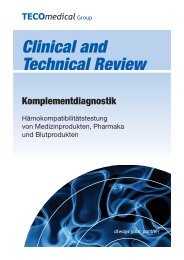
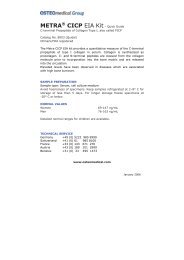
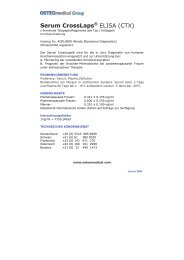
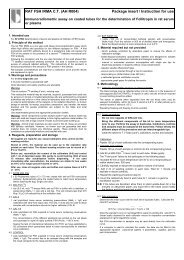

![PTH [Hormone Parathyroïdienne] Intacte ELISA](https://img.yumpu.com/1233682/1/190x245/pth-hormone-parathyroidienne-intacte-elisa.jpg?quality=85)
